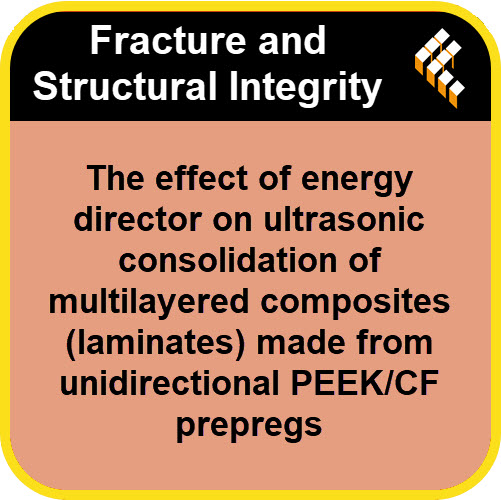Fracture and Structural Integrity: The Podcast
Stay at the cutting edge of fracture mechanics and structural integrity research with the official podcast of the Fracture and Structural Integrity journal. Join us for insightful interviews with top researchers, in-depth discussions of groundbreaking papers, and explorations of emerging trends in the field.
RSS Spotify YouTube Amazon Music
The effect of energy director on ultrasonic consolidation of multilayered composites (laminates) made from unidirectional PEEK/CF prepregs
2025-11-12
https://www.fracturae.com/index.php/fis/article/view/5691
The study aims at assessing the effects of the ultrasonic consolidation parameters and the insertion of energy directors from the commercially available polyetheretherketone film ~250 µm thick on the structure and mechanical properties of the layered composites (laminates). Commercially available polyetheretherketone-based prepregs reinforced with tapes of unidirectional carbon fibers were ultrasonically consolidated with and without energy directors from neat polyetheretherketone film using an ‘UZPS-7’ ultrasonic welding machine. The laminates without the energy directors consisted of 16 prepreg layers, while 7 and 6 layers of the prepregs and the energy directors, respectively, included the other ones to ensure similar thicknesses during subsequent interlaminar shear strength tests. In the laminates with the energy directors, prolonging the ultrasonic duration allowed for the prepreg interfaces to be virtually blurred, increasing the interlaminar shear strength value up to the maximum level of 60 MPa. With the energy directors, excessive melting and spreading of the polymer occurred at the prolonged ultrasonic durations, increasing the number of discontinuities at the layer interfaces, including delamination and the impregnation of the prepregs with the excessive binder. The ultrasonic duration of 800 ms was the most rational, as it enabled to reduce the damaging effect of applied ultrasonic vibrations on the joined layers (prepregs), increasing the interlaminar shear strength value above 50 MPa.
DownloadFiletype: MP3 - Size: 3 MB - Duration: 13:25m (320 kbps 44100 Hz)
Powered by Podcast Generator, an open source podcast publishing solution | Theme based on Bootstrap
